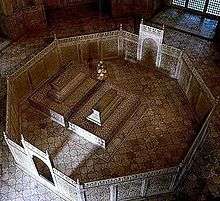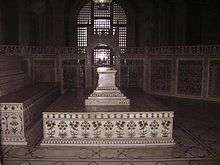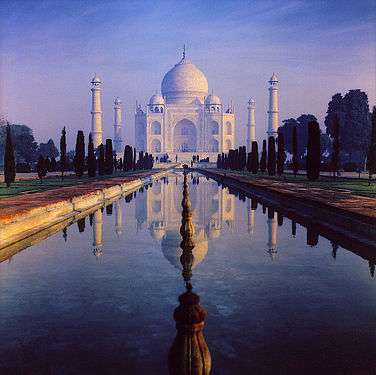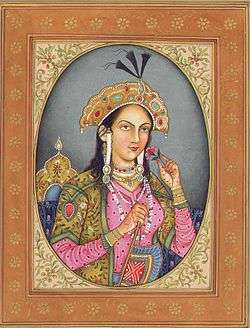Mumtaz Mahal
| Mumtaz Mahal | |||||
|---|---|---|---|---|---|
| Queen of India ملکہ ہندوستان | |||||
|
An artistic depiction of Mumtaz Mahal | |||||
| Empress and chief consort of Mughal | |||||
| Predecessor | Nur Jahan | ||||
| Padshah Begum of the Mughal Empire | |||||
| Tenure | 30 January 1628 – 17 June 1631 | ||||
| Predecessor | Nur Jahan | ||||
| Successor | Jahanara Begum | ||||
| Born |
April 1593 Agra, Mughal Empire | ||||
| Died |
17 June 1631 (aged 37) Burhanpur, Mughal Empire | ||||
| Burial | Taj Mahal, Agra, now India | ||||
| Spouse | Shah Jahan | ||||
| Issue |
Hur un-nisa Begum (1613–1619) Jahanara Begum (1614–1681) Dara Shikoh (1615–1659) Shah Shuja (1616–1661) Roshanara Begum (1617–1661) Aurangzeb (1618–1707) Ahmad Bakhsh (1619–1622) Surayya Banu Begum (1621–1628) Unnamed son (1622) Murad Baksh (1624–1661) Lutfu'llah (1626–1628) Daulat Afzal (1628–1629) Husnara Begum (1630) Gauhara Begum (1631–1707) | ||||
| |||||
| House | Timurid (by marriage) | ||||
| Father | Abdul Hasan Asaf Khan | ||||
| Mother | Plondregi Begum | ||||
| Religion | Shia Islam | ||||

Mumtaz Mahal (April 1593 – 17 June 1631)[1] [mumˈt̪aːz mɛˈɦɛl]; meaning "the elect of the palace" was a Mughal Empress and chief consort of Emperor Shah Jahan. The Taj Mahal in Agra was constructed by her husband as her final resting place.
She was born as Arjumand Banu Begum in Agra, to a family of Persian nobility. She was the daughter of Abdul Hasan Asaf Khan. Arjumand Banu Begum was married at the age of 19, on 10 May 1613, to Prince Khurram, later known to be Emperor Shah Jahan, who conferred upon her the title "Mumtaz Mahal". Although betrothed to Shah Jahan in 1607, she ultimately became his 4th wife in 1612. Mumtaz Mahal mothered fourteen children by Shah Jahan, including Jahanara Begum, and the Imperial Prince Dara Shikoh, the heir apparent, anointed by Shah Jahan, who temporarily succeeded him, until deposed by Mumtaz Mahal's sixth child, Aurangzeb.
She died in Burhanpur in the Deccan (now in Madhya Pradesh) during the birth of their fourteenth child, a daughter named Gauhara Begum.[2] Shah Jahan had the Taj Mahal built as a mausoleum for Mumtaz Mahal, which is considered to be a monument of "undying love".[3]
Early years

aamish banu Begum was born in Agra. She was the daughter of Abdul Hasan Asaf Khan, making her a niece, and later, a stepdaughter-in-law of Empress Nur Jehan, the wife of the Emperor Jahangir, Shah Jahan's father.[4] Her older sister, Parwar Khanum, married Sheikh Farid, the son of Nawab Qutubuddin Koka, the governor of Badaun who was also the emperor Jahangir's foster brother. Empress Mumtaz was religiously a Shia Muslim.[5]
Marriage
Mumtaz Mahal became betrothed to Shah Jahan in 1607 AD (1016 AH), when she was 14 years old at the time. They were, however, married five years after the year of betrothal, in 1612 AD (1021 AH). After their wedding celebrations, Shah Jahan, "finding her in appearance and character elect among all the women of the time", gave her the title "Mumtaz Mahal" Begum (Chosen One of the Palace).[6] During the intervening years between their betrothal and marriage, Shah Jahan had gotten married to his first wife in 1612 AD, and in 1617 AD, after marrying Mumtaz, took a third wife. But by all accounts however, Shah Jahan was so taken with Mumtaz that he showed little interest in exercising his polygamous rights with the two earlier wives, other than dutifully siring a child with each. According to the official court chronicler, Motamid Khan, as recorded in his Iqbal Namah-e-Jahangiri, the relationship with his other wives "had nothing more than the status of marriage. The intimacy, deep affection, attention and favour which His Majesty had for the Cradle of Excellence (Mumtaz) exceeded by a thousand times what he felt for any other."[6][7] Therefore, Shah Jahan bestowed Mumtaz with luxuries that no other queen was given. For example, no other queen's residence was as decorated as Khas Mahal (part of Agra fort), where Mumtaz lived with Shah Jahan. It was decorated with pure gold and precious stones and had rose water fountains of its own.
Mumtaz Mahal had a loving marriage with Shah Jahan. Even during her lifetime, poets would extol her beauty, grace, and compassion. She was Shah Jahan's trusted companion, traveling with him all over the Mughal Empire. His trust in her was so great that he gave her the highest honour of the land — his imperial seal, the Mehr Uzaz.[1] Mumtaz was portrayed as having no aspirations to political power, in contrast to her aunt, Empress Nur Jehan, the chief consort of Emperor Jahangir, who had wielded considerable influence in the previous reign.[8] A great influence on him, apparently often intervening on behalf of the poor and destitute, she also enjoyed watching elephant and combat fights performed for the court. It was quite common for women of noble birth to commission architecture in the Mughal Empire, so Mumtaz devoted some time to a riverside garden in Agra.[1]
Despite her frequent pregnancies, Mumtaz travelled with Shah Jahan's entourage throughout his earlier military campaigns and the subsequent rebellion against his father. She was his constant companion and trusted confidant, leading court historians to go to unheard lengths to document the intimate and erotic relationship the couple enjoyed. In their nineteen years of marriage, they had fourteen children together, seven of whom died at birth or at a very young age.[2]
When Shah Jahan travelled from Balapur Fort to Burhanpur, mother of Mirza Azam and elder daughter of Shahzada Mirza Badi-uz-Zaman Safavi, alias Shah Nawaz Khan of the Safavid dynasty, the princess Dilras Banu Begum, wife of Aurangzeb along with Mumtaz and cousin/brother Shah Beg Khan, along with military personnel - stayed three nights near Argaon at Hiwarkhed, before the birth of their fourteenth child.[1]
Death and aftermath
Mumtaz Mahal died in Burhanpur in 1631 AD (1040 AH) while giving birth to her fourteenth child.[2] She had been accompanying her husband while he was fighting a campaign in the Deccan Plateau. Her body was temporarily buried at Burhanpur in a walled pleasure garden known as Zainabad originally constructed by Shah Jahan's uncle Daniyal on the bank of the Tapti River.[9] The contemporary court chroniclers paid an unusual amount of attention to Mumtaz Mahal's death and Shah Jahan's grief at her demise. In the immediate aftermath of his bereavement, the emperor was reportedly inconsolable.[10] Apparently after her death, Shah Jahan went into secluded mourning for a year.[10] When he appeared again, his hair had turned white, his back was bent, and his face worn.[3] Shah Jahan's eldest daughter, Jahanara Begum, gradually brought him out of grief and took the place of Mumtaz at court.
Her personal fortune (valued at 10,000,000 rupees) was divided by Shah Jahan between Jahanara Begum, who received half and the rest of her surviving children.[11] Burhanpur was never intended by her husband as his wife's final resting spot. As a result, her body was disinterred in December 1631 and transported in a golden casket escorted by her son Shah Shuja and the head lady in waiting of the deceased Empress back to Agra.[12] There it was interred in a small building on the banks of the Yamuna River. Shah Jahan stayed behind in Burhanpur to conclude the military campaign that had originally brought him to the region. While there, he began planning the design and construction of a suitable mausoleum and funerary garden in Agra for his wife. It was a task that would take more than 22 years to complete: the Taj Mahal.

A crater was named in her honour on asteroid 433 Eros, along with another one after her husband.
The Taj Mahal
The Taj Mahal was commissioned by Shah Jahan to be built as a mausoleum for Mumtaz Mahal. It is seen as an embodiment of undying love and marital devotion. English poet, Sir Edwin Arnold describes it as "Not a piece of architecture, as other buildings are, but the proud passion of an emperor's love wrought in living stones." The beauty of the monument is also taken as a representation of Mumtaz Mahal's beauty and this association leads many to describe Taj Mahal as feminine.[13] Since Muslim tradition forbids elaborate decorations on graves, the bodies of Mumtaz and Shah Jahan are placed in a relatively plain crypt beneath the inner chamber with their faces turned right and towards Mecca.[14] The Ninety Nine Names of God are found as calligraphic inscriptions on the sides of the tomb of Mumtaz Mahal, in the crypt including “O Noble, O Magnificent, O Majestic, O Unique, O Eternal, O Glorious…".[15] There are many theories about the origin of the name of this tomb and one of them suggests that 'Taj' is an abbreviation of the name Mumtaz. European travelers such as François Bernier who observed its construction, were one of the first to call it the Taj Mahal. Since it is unlikely that they came up with the name, it is suggested that they might have picked it up from the locals of Agra who called the Empress 'Taj Mahal and thought the tomb was named after her and the name began to be used interchangeably. However, there is no firm evidence to suggest this. The Taj Mahal was not initially intended to entomb more than one person however, when Shah Jahan died, Aurangzeb had him buried next to the tomb of Mumtaz Mahal.[13]
Citations
- 1 2 3 4 "Mumtaz Mahal - Mumtaz Mahal Life History - Mumtaj Mahal Biography - Mumtaz Mahal and Shah Jahan". www.tajmahal.org.uk. Retrieved 2016-11-04.
- 1 2 3 Kumar, Anant (January–June 2014). "Monument of Love or Symbol of Maternal Death: The Story Behind the Taj Mahal". Case Reports in Women's Health. Elsevier. 1: 4–7. doi:10.1016/j.crwh.2014.07.001. Retrieved 21 December 2015.
- 1 2 Begley, Wayne E. "The Myth of the Taj Mahal and a New Theory of Its Symbolic Meaning" (PDF). The Art Bulletin. 61.
- ↑ Abu Fazl 'Allami, Áín i Akbarí
- ↑ "Waqf board handles Muslim rulers' property". The Times Of India. 2 October 2010. Retrieved 30 June 2011.
- 1 2 Koch, page 18.
- ↑ Qazwini. fol. 233a translated by Begley and Desai (1984), page 14.
- ↑ Koch, page 19.
- ↑ Preston, page 171.
- 1 2 Koch, page 20.
- ↑ Preston, page 175.
- ↑ Preston, page 176.
- 1 2 Tillotson, Giles (2008). Taj Mahal. LONDON: Harvard University Press. ISBN 9781847652478 – via Google Books.
- ↑ Khatri, Vikas (2012). Greatest Wonders of the World. V S Publishers. p. 128. ISBN 9381588309.
- ↑ "Taj Mahal Calligraphy". Taj Mahal. Retrieved 2016-11-27.
References
- Koch, Ebba. The Complete Taj Mahal: And the Riverfront Gardens of Agra (Hardback) (First ed.). Thames & Hudson Ltd. pp. 288 pages. ISBN 0-500-34209-1.
- Preston, Diana & Michael (2007). A Teardrop on the Cheek of Time (Hardback) (First ed.). London: Doubleday. pp. 354 pages. ISBN 978-0-385-60947-0.
- Tillotson, Giles (2008). Taj Mahal. London: Harvard University Press. pp. 208 pages. ISBN 978-1-84765-247-8.
External links
![]() Media related to Mumtaz Mahal at Wikimedia Commons
Media related to Mumtaz Mahal at Wikimedia Commons
